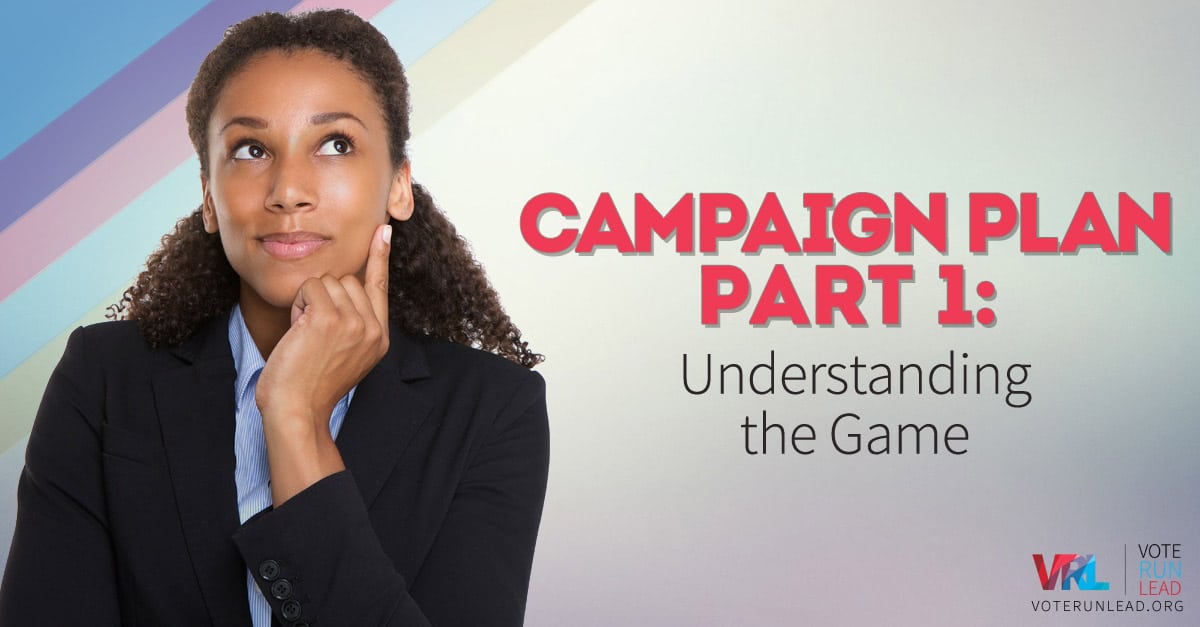Campaign Plan Part 1 – Understand the Game

The Campaign Plan in Three Parts
Ok. So you’ve made the decision to run. You know what you want to run for. Now it’s time to get serious. Here we go!! The Campaign Plan Timeline will help you to think about the “big picture”. Lots of details will go into your plan, but this will help you organize what it takes to run a campaign.
Work backwards. If you’ve planned a big event like a gala for work, a 50th anniversary party, or you’ve mapped your own personal goals then this is something you can do. Yes, it will feel overwhelming at times – lots of dates to remember! – but that is what your local clerk’s office or board of elections is for and why you pull together a great team around you!
Our motto “Plan the Work. Work the Plan.” Whether it’s 5 years or 5 months (or even 5 weeks), this timeline will help you create a great campaign plan. Remember. If it’s not written down, it’s not a plan.
Part 1: Understand the Game
- Form Your Kitchen Cabinet
- Assess the Lay of the Land
- Make It Official
- Your Campaign Team
- The Plans within the Plans (Budgets, Messaging and Voter Contact aka “Field” Plans)
- Lists, list and more lists!
- Being The Candidate – Your Role: Fundraising and Contacting Voters
- Communicate
- Get-Out-The-Vote
HERE WE GO!
#1 UNDERSTAND THE GAME
1. Form Your Kitchen Cabinet:
Look for people who bring different strengths to the table. This includes:
– political guidance
– stature in the community
– can help you raise money
– family support
– diverse connections
– honesty, straight-talk feedback
– confidential and trustworthy
– writing
– social media savvy
– positive energy!
– has run a campaign / been a campaign treasurer before
2. Lay of the Land
The more you understand the community you seek to represent, the better you will be able to serve them; often called “the lay of the land” or the “political landscape”. We’ve mapped six buckets to understand your political landscape.
| Money and Vote Numbers
In many states, the party you belong to or the legislative caucus or the previous campaign will have this data. You might have to hound them for it. But it’s key. Find out:
|
Information About You Get someone (not you!) to help you with this part. Take an inventory of your networks and connections: Find out:
|
| Political/Cultural Information
Any campaign is a part of a larger community and political culture. Know what can influence voters outside of your race. Find out:
|
Important Dates and Events This is critical for you personally and for the community at large. Ask yourself:
|
| Movers and Shakers
How can people you know help with their influence, networks and ties in the community? Are there people you need to reach out to and start new relationships? Find out:
|
Opposition Research You don’t need to know everything about your opponent right away, but you should have a handle on your opponent(s) viewpoints and history, and continue to keep an eye on them. “Opposition research” may feel yucky but it is important to seize opportunities that set you apart from the pack and show voters why you are the better choice. You don’t have to play dirty but you do need to give the voters a clear choice between you and the other guys! Find out:
|
3. Make it Official: There is a kind of coming out when you are ready to run. Be prepared. You’ve spoken with your friends and family. The next step is to be in touch with other influencers who need to know that you are running. Finally, you need to file your candidacy with your local clerk’s office often found in the elections division of local government. Make sure you know the official requirements and key deadlines.
Now that you understand the game, get ready to plan the work with Campaign Plan for Women Part 2.
There’s plenty more where this came from!

Sign up today to attend one of our VRL Live! Web Clinics or events and receive seasoned advice on how to ramp up your run for office, campaign, craft your message, and much more. Between sessions, don’t forget, you can always access our resource library and the entire archive of VRL Live! Replays to continue building your political leadership skills and learning how to run for office at your own pace.